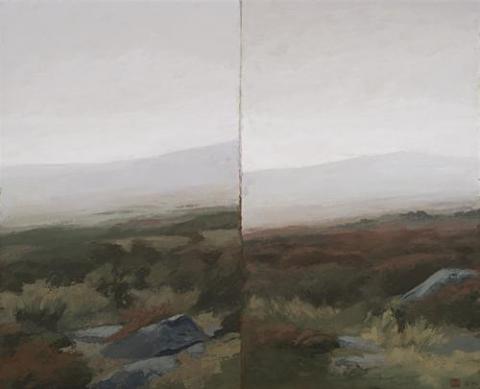FAULT LINE, 1995
Philip Wolfhagen
oil and wax on linen
175.0 x 217.0 cm
signed and dated lower right: artists stamp W 95
inscribed with title, date and artist's name and address on stretcher verso
Sherman Galleries, Sydney
Private collection, Sydney
Moet & Chandon Travelling Exhibition, National Gallery of Victoria, Melbourne, and touring major state galleries, 1996
Although only capturing the attention of collectors and critics from the mid-1990s onwards, Tasmanian artist Philip Wolfhagen is today recognised as one of the country's most outstanding landscape painters. Drawing inspiration from the terrain of his personal origins - namely the Great Western Tiers which presided over his childhood and youth - indeed Wolfhagen remains unique among his contemporaries for his images of great beauty which, contemplating desolation, isolation and tranquility, reflect 'the feeling of spiritual elation I experience when I achieve in a passage of paint, what I had in mind and soul.'1
Graduating from the Sydney College of Arts in 1990, Wolfhagen had initially pursued a romantically-inflected landscape naturalism, with his first solo exhibition at Salamanca Place later that year - a show of clouds and sky - openly declaring his artistic allegiance to John Constable. Yet, if Wolfhagen, like his nineteenth-century predecessor, seeks the more solemn, enduring qualities - the 'essence' of a landscape - he nevertheless strongly rejects the romantic concept of nature as awesome and formidable, 'the threatening other.' Rather, for Wolfhagen, who grew up steeped in the natural environment, '...it's not 'out there'; it's in 'here', part of his psyche. If there's a sense of awe in his paintings, it emanates from an ingrained, sustained reverence for nature, not from the experience of epiphanic moments of revelation...'2
Sombre in mood and tonality, Fault Line 1995 is poignant testimony to the artist's deeply experienced, enduring engagement with an ancient - yet eternally living - subject.
Raising important issues about the relationship between nature, abstraction and the spiritual, the work eludes a postcolonial view of the landscape in the deliberate omission of any sign of human intervention or superficially seductive incident. Thus, Wolfhagen encourages the viewer to engage unimpeded with the deeper suggestiveness of his subject
'...the horizon line separates the earth-toned solid matter of the terrain with the cool blue distant incorporeal space of clouds and sky; the division if you like between mind and matter, the corporeal and the spiritual. This is nature pure and simple; it is neither colonised, romanticised not aggrandised, but is sturdy and enduring, something which Wolfhagen's paintings insist remains lodged in human consciousness, in spite of more than a century of our progressive alienation from the natural world.'3
1. Wolfhagen cited at http://www.christineabrahamsgallery.com.au/adisplay.cfm?id=91
2. Hammond cited in Wolfhagen, exhibition catalogue, Sherman Galleries and The Beagle Press, Sydney, 1996, p. 3
3. ibid., p. 4
VERONICA ANGELATOS
